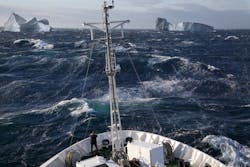What is the next new? How can we best navigate the unknown and find a way to make it part of our next solution? How do we purchase rapid evolution? Navigate uncharted water
How do we build on "advanced technology indistinguishable from magic"?
The "next new" approach requires the complete buy-in and total support of the owner wishing to improve their users' experience. The assembled team needs an appetite to share and understand the risk/excitement of implementing deep innovation, doing what has never been done using newly discovered unknowns. The need is to Nurture Now, fostering/overseeing the development of next news like "AI" ( my definition, Additional Intelligence) while greatly improving the "UX" ( User eXperiences ) and providing an enjoyable journey into the newly purposed buildings designed to enhance occupants, not just house them.
From owning sailboats and sailing for over 30 years on the pacific northwest coast of America—often in uncharted waters—these tips for navigation would seem to apply to "Navigating Next New":
Visual - A person on the bow with quick reporting of unseeing danger to captain/navigator is mandatory.
Data - dead reckoning, built on your last known position. The ability to retreat quickly the exact course you came is very useful
Agility - Use a smaller boat to explore big potential problems. Keep in mind speed of response. Know your fastest speed achievable, be on the outlook for faster currents, submerged rocks, kelp, flotsam, jetsam etc.
Safety - at all times keep the mother ship safe. Always keep eye on the weather short and long-range. Always know the flow of the tide, its direction, strength and when it will change. Use the present current flow and the winds of change to your advantage anytime you can.
And of course, have fun and learn to use rapid adaptation; identify what information that has changed and what and who you can trust.
Once you have your head around this careful navigation you can start selling and explaining what you know to be true and trusted to your followers.
I love the Shopify creation story, an online shopping platform started from a frustrated snowboard company. The Devil is the need to do what has never been done before but is badly needed. We started AutomatedBuildings.com over 22 years ago, because none of our industry paper magazines would publish my outlandish thoughts. Our goal was to build a B2B following and sell our e-magazine resource to one of the paper magazines and again retire.
Most print magazines dedicated to our industry are now gone or have morphed and splintered into special-interest newsletters and social media accounts and we are (of course) still here. We are still trying to document and connect our further fragmented industry while we Navigate the Next New.
As the flames on my torch burn closer, I wonder who will document the next 20 years? Any volunteers? Or will AI organize and present all our histories?
Why not take a quick look at some of our recent history?
Building a Digital Family of Trust
New technologies are solving old problems while creating new concerns.
How important is the User Experience?
This Memoori article predicts that the workplace experience apps market within commercial office space will rise to $988 million by 2025.
From Monday Live, a video of our great discussion about Smart Building User Experience with Paul Maximuk from Newcomb & Boyd, LLP.
Here’s another great Monday Live, this time our June 28 session with our own contributing editor Nicolas Waern. This session introduced the July Issue of AutomatedBuildings.com.
And speaking of July, here are some highlights from our July articles and LinkedIn posts.
First, Is Changing the Narrative Part of the New? By Marc Petock, Chief Marketing and Communications Officer for Lynxspring, Inc.:
Smart buildings are not new for those of us in the industry, but they remain relatively misunderstood entities for many operators. Generally, owners and operators understand that smart buildings are rich in technology that is supposed to improve their operations, make them more efficient, but they all-too-often, find themselves struggling to understand the technology and adapt to the way the technology should be a must-have instead of a nice to have.
When it comes to change, we intuitively think disruption; especially in our post-pandemic recovery, where change is happening all the time and as we continue the digital transformation journey of integrating people, processes, and technology. However, the potential of change doesn’t just wait for the future, it also rests in the past. Change can help us re-evaluate and improve on many past breakthroughs, rendering them viable again or perhaps even for the first time.
What's Next After AI? A discussion with Toby Ruckert published on July 4, 2021. Key passage:
Today, AI stands as the epitome of technology. It has become the most revolutionizing factor our world has seen over the course of the last few centuries since magnetism, electricity, quantum physics, and more, have been discovered.
There is not a single area of science and society not being disrupted by two of AI’s core capabilities: accelerated discovery and speed of execution. Since data is now abundantly available in broad, large scale as well as in narrow, specific structures, and combined with computing power processing nearly limitless amounts of data in record time, it’s clear AI is not only here to stay, but also here to define our way. Which begs the question: what’s next after AI?
Taming an unborn Beast—Artificial Intelligence (AI) by Sudha Jamthe, Technology Futurist and CEO of IoTDisruptions:
Artificial Intelligence (AI) is pervasive and is permeating all jobs and all walks of life in every industry. It comes with huge power to automate mundane jobs and create new conveniences and opportunities but it comes with its limitations impacting lives when it is incorrect in its predictions. But the AI that we work with is constantly learning and adapting to recreate itself as it interacts with people and new situations.
All AI is a Prediction.
AI is everywhere and it works by prediction. AI is trained with data we feed it. Then when we engage it to work, it makes a prediction. Every single time.
Ask AI for a financial forecast, whether we should expect an upcoming storm, or about how much power will be generated by wind for sustainability. It will readily give us the answer. All of them are predictions.
Critical answers from an AI such as whether someone has Covid or Alzheimers is a prediction.
What appear as silly things with auto-correct on our texts or search engines are all predictions.
Ask Google search 'On Thursday I will' and it will say I will get paid. Ask Google 'On Thursday you would' and it will say you will get pregnant. That is a prediction too.
Why Should AI be Tamed?
AI is unleashing great power impacting lives and creating a new future for the world-impacting everyone and everything.
AI is being used to create synthetic media or deep fakes. This distorts the idea of what is real news and creates fake news that propagates misinformation campaigns in the wrong hands. AI can create artificial human images and distort real videos such that we cannot see what is real or doctored. The challenge with AI is that there are positive and negative applications to AI. Listen to Manon De Dunne’s talk to understand the power and challenges of synthetic media using artificial intelligence below.
Taming the AI, making it work is like trying to work with the future that has not yet been created. It is about predicting the future before it is built.
How NUDE(D) do we need to be to Navigate the Next New? By Nicolas "The Building Whisperer” Waern:
The NUDE acronym could provide a good starting point to reflect on how technology (IT) is being viewed by companies, as well as individuals. The way how we view IT can be of a huge difference for us, and our organizations. Coupled with RGT, Run, Grow, Transform, NUDE can be a powerful tool to start the future.
NUDE stands for the different perspectives of how organizations can view technology.
None - There are no synergies between business and technology
Utility - Cost/rational perspective, where it is being used, but not thought of
Dependent - The business side of things is linked to technology and is needed to run daily operations
Enabling - Technology is an integrated part of the strategy process and it is a dynamic interaction between the cognition of strategy and technology. Investments are made to create a competitive advantage over others.
And also the new addition to NUDE,
DNA.
A Digital DNA. That is what companies today are competing with. Not their industry peers. Not the dinosaurs of yore. But the companies that have speed, and AI-ready data fabrics in their digital operating models and digital business models.
Platform Wars—the glue for digital building data by Scott Cochrane, President & CEO, Cochrane Supply:
A Software Platform provides the glue for all the digital building data to be aggregated, normalized, redistributed, and secured, all while providing real-time control for mechanical and electrical systems. In the old days that meant the BAS graphics. But, with systems integration, open API’s and the Internet, holy crap! It's a new day when it comes to BAS software capabilities!
Are you having problems specifying rapidly evolving building automation? We have been here before; this 20-year-old article talks about solutions which I feel are very relevant now:
The Request For Proposal (RFP) approach has been used by the Information Technology (IT) industry for several years. This approach allows the purchaser to focus on actual functional requirements rather than being confused with the various technologies supplied by vendors. Time is well-spent defining mandatory requirements and gives a clearer understanding of how the technology will achieve our goals. Once mandatory requirements and "nice to have" features are defined we can send out a Request For Proposal to allow vendors to use different technologies to present proposals on how they will meet our requirements as well as expounding on their ability to provide further enhancements.
How do we Nurture & Navigate the Next New? Take a firm hold on the helm as you head into turbulent, confused seas and uncharted water. Keep in mind your destination (your Mandatory Requirements) as you steer your course.
Have fun and learn to use rapid adaption. Identify what information has changed and what and who you can trust. Be prepared—you may have to kiss the devil.
About the Author
Ken Sinclair
Editor/Owner/Founder
Ken Sinclair has been called an oracle of the digital age. He sees himself more as a storyteller and hopes the stories he tells will be a catalyst for the IoT future we are all (eventually) going to live. The more than 50 chapters in that ongoing story of digital transformation below are peppered with HTML links to articles containing an amazing and diverse amount of information.
Ken believes that systems will be smarter, self-learning, edgy, innovative, and sophisticated, and to create, manage and re-invent those systems the industry needs to grow our most important resource, our younger people, by reaching out to them with messages about how vibrant, vital and rewarding working in this industry can be.

